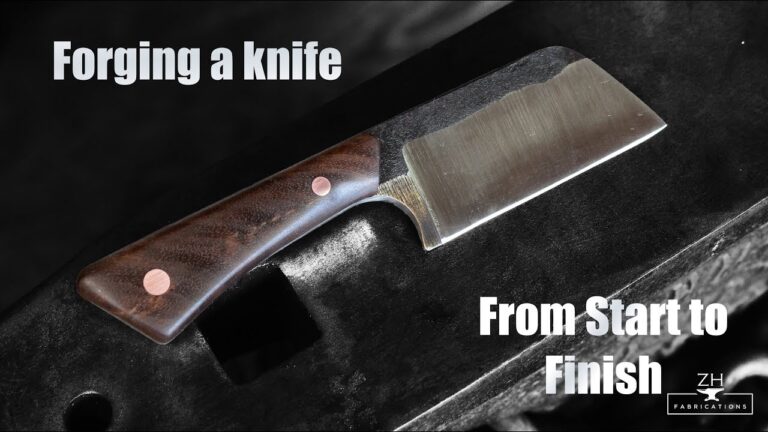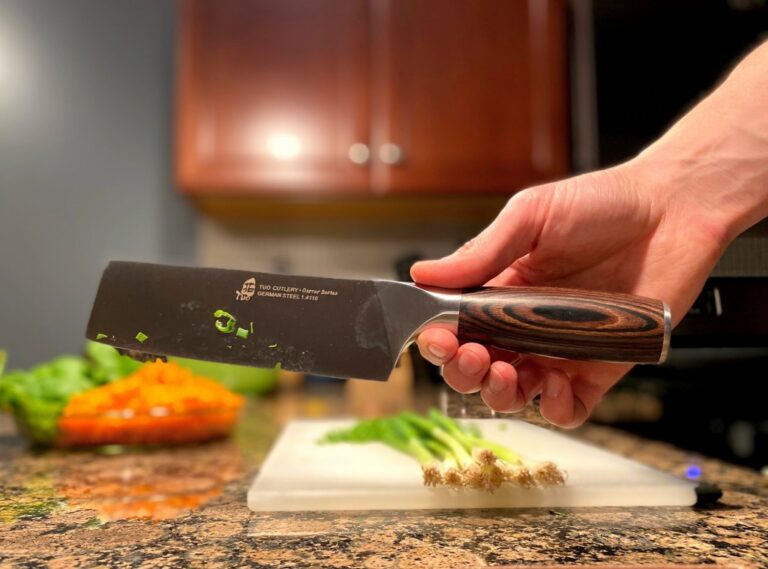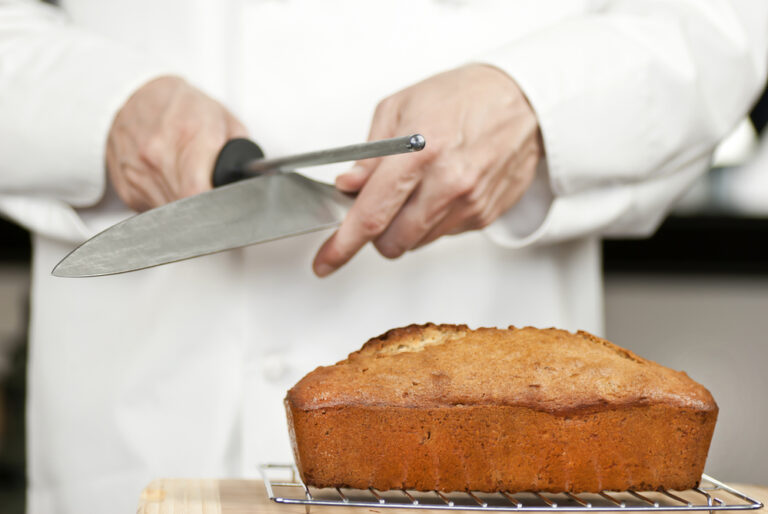Nakiri VS Santoku Knife: What’s the Difference?
A Nakiri knife is a traditional Japanese knife used for cutting vegetables. It is typically shorter and thicker than a chef’s knife and has a straight edge. The name “Nakiri” literally means “leaf cutter.”
A Santoku knife is also a Japanese knife, but it is a general-purpose knife that can be used for cutting meat, fish, and vegetables. The name “Santoku” means “three virtues” or “three uses,” referring to its ability to handle meat, fish, and vegetables. It typically has a shorter blade and a straighter edge than a chef’s knife.

| FEATURES | NAKIRI | SANTOKU |
| Used for | Cutting vegetables and fruits. | Cutting fish, fruit, vegetables, cheese, and meat. |
| Weight | 7.5 to 9.4 ounces | 6.5 to 8.5 ounces |
| Edge grind | Double-bevel | Single or double bevel |
| Blade Length | 5-7 inches | 5-7 inches |
| Cutting Action | Straight up and down | Rocking,sicing, up and down. |
| Sharpness | Sharp to an extent of 28-34 degrees. | Sharp to an extent of 20-30 degrees. |
| Cost | Less expensive | More expensive |
What Is A Nakiri Knife Mostly Used For
A Nakiri knife is primarily used for cutting vegetables. The knife’s straight edge allows for precise and efficient chopping, slicing, and dicing of vegetables. The thin and sharp blade is especially useful for delicate vegetables like tomatoes, eggplants, and mushrooms. The Nakiri’s taller blade also allows for easy transfer of ingredients from the cutting board to the pan or pot. Additionally, its square tip is helpful for tasks such as removing the stems from vegetables.
Read more about What is a Nakiri Knife And Why You Need It.
Advantages of Nakiri knife
There are several advantages to using a Nakiri knife:
Read more about Best Nakiri Knives
What Is A Santoku Knife Mostly Used For
A Santoku knife is a general-purpose knife, often referred to as a “Japanese Chef’s knife”, that is primarily used for cutting meat, fish, and vegetables. The name “Santoku” means “three virtues” or “three uses,” referring to its ability to handle meat, fish, and vegetables, it is very versatile and can be used for a wide range of tasks in the kitchen, including chopping, slicing, mincing, dicing, and even crushing garlic.
It has a shorter and straighter edge than a Western-style chef’s knife, which makes it well-suited for cutting through foods with a firm texture. The knife’s shape also allows for a rocking motion, making it easy to chop herbs and mince garlic. Additionally, the flat edge is useful for crushing and grinding ingredients.
Advantages Of Santoku Knife
There are several advantages to using a Santoku knife:
Nakiri VS Santoku Knife:
Similarities Between Nakiri and Santoku
Nakiri and Santoku knives are both traditional Japanese knives, and they have several similarities:
Both are used for cutting vegetables: Nakiri knives are specifically designed for cutting vegetables, while Santoku knives are general-purpose knives that can also be used for cutting vegetables.
Both have straight edges: The straight edge of both knives allows for precise and efficient cutting, making them well-suited for slicing and dicing vegetables, fruits, and meats.
Both are relatively short: Both Nakiri and Santoku knives have sharper blades than Western-style chef’s knives, which makes them more maneuverable and easier to control.
Both are easy to sharpen: Both Nakiri and Santoku knives are relatively easy to sharpen and maintain a razor-sharp edge, ensuring that they are always ready to use.
Both are comfortable to hold: Both Nakiri and Santoku knives are comfortable to hold, which reduces hand fatigue during prolonged use.
Both are well-suited for a variety of kitchen tasks: Both Nakiri and Santoku knives can be used for a wide range of tasks in the kitchen, including chopping, slicing, mincing, and dicing.
Read more about whether Should I buy a Nakiri Knife. Detailed Answer;
Differences Between Nakiri and Santoku
While Nakiri and Santoku knives have some similarities, there are also several key differences between them:
Purpose: Nakiri knives are specifically designed for cutting vegetables, while Santoku knives are general-purpose knives that can be used for cutting meat, fish, and vegetables.
Blade shape: Nakiri knives have taller and thinner blades, while Santoku knives have shorter and thicker blades.
Blade length: Nakiri knives typically have a longer blade than Santoku knives.
Tip shape: Nakiri knives have a squared tip, while Santoku knives have a rounded tip.
Handle shape: Nakiri knives have a rectangular handle shape, while Santoku knives have a round handle shape
Cutting style: Nakiri knives are primarily used for chopping, slicing, and dicing vegetables, while Santoku knives are best for slicing, dicing, and mincing.
Blade edge: Nakiri knives have a straight edge, while Santoku knives have a curved edge that allows for rocking motion, which is well-suited for chopping herbs and mincing garlic.
Western vs. Japanese style: Nakiri and Santoku knives are both traditional Japanese knives, while Western chef’s knives are different in shape and cutting style.
Conclusion
Both the santoku and nakiri knives are designed for cutting vegetables, but they have different shapes and are used in slightly different ways. Both knives are great for their intended uses, it all depends on your preference. If you are looking for a versatile knife that can be used for meat and fish, then the Santoku knife would be a great choice. If you are looking for a knife specifically designed for cutting vegetables, then the Nakiri knife would be the best choice.



